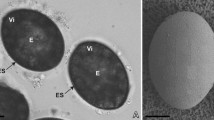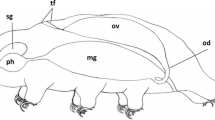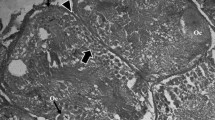Summary
The ultrastructure of the inclusions in the test cell of the unfertilized egg and the oocyte in later vitellogenesis of the ascidian,Ciona robusta, was studied. The granules first appear in the cytoplasm of the test cell when it is embedded in the cortex of the oocyte, and the granules gradually condense into a mass. The electron-density of the condensed masses of test granules gradually increases and the number of masses increases until the cytoplasm of the test cell is filled with them. When the test cell leaves the oocyte, the mass gradually loses the electron-density from its central part to its periphery and finally becomes a myeline-like structure enveloped in a large vacuole. In later vitellogenesis small vacuoles with moderately electron-dense granules newly appear in the test cell. The granules are scattered in these vacuoles or sometimes gathered to form a net.
X-ray microanalysis revealed that considerable vanadium and iron are detectable in the condensed masses of test granules but there is little in the myeline-like structure of the unfertilized egg or the oocyte in later vitellogenesis. The relationship between the morphological transition of the inclusions in the test cell and the accumulation of vanadium was discussed with respect to the observed results.
Similar content being viewed by others

References
Baltscheffsky, H., Baltscheffsky, M., 1953: Vanadium content and distribution inPhallusia mamillata Cuvier. Pubbl. Staz. Zool. Napoli24, 447–451.
Bielig, H. J., Bayer, E., Dell, H. D., Rohns, G., Möllinger, H., Rüdiger, W., 1966: Chemistry of hemovanadin. In: Protides of the biological fluids14, pp. 197–204. Burges, Belgium: Elsevier Publishing Co.
—,Jost, E., Pfleger, K., Rummel, W., Seifen, E., 1961 a: Aufnahme und Verteilung von Vanadin der TunicatePhallusia mammillata Cuvier (Untersuchungen über Hämovanadin, V). Hoppe-Seyler's Z. physiol. Chem.325, 122–131.
—,Pfleger, K., Rummel, W., Seifen, E., 1961 b: Aufnahme und Verteilung von Vanadin bei der TunicateCiona intestinalis L. Hoppe-Seyler's Z. physiol. Chem.326, 249–258.
Biggs, W. R., Swinehart, J. H., 1976: Vanadium in selected biological systems. In: Metal ions in biological systems6, pp. 141–196. New York: Marcel Dekker.
Botte, L., Scippa, S., 1979: Vanadium and other metals inAscidia malaca. Annot. Zool. Japon.52, 151–153.
—,Scippa, S., de Vincentiis, M., 1979: Ultrastructural localization of vanadium in the blood cells ofAscidiacea. Experientia35, 1228–1230.
Califano, L., Caselli, P., 1948: Ricerche sulla emovanadina. I. Dimostrazione di una proteina. Pubbl. Staz. Zool. Napoli21, 261–271.
Ciereszko, L. S., Ciereszko, E. M., Harris, E. R., Lane, C. A., 1963: Vanadium content of some tunicate. Comp. Biochem. Physiol.8, 137–140.
Endean, R., 1955: Studies of the blood and tests of some Australian ascidians I. The blood ofPyura stolonifera (Heller). Austral. J. Mar. Freshw. Res.6, 35–59.
Henze, M., 1911: Untersuchungen über das Blut der Ascidien I. Mitteilung. Die Vanadiumverbindungen der Blutkörperchen. Hoppe-Seyler's Z. physiol. Chem.72, 494–501.
Kalk, M., 1963 a: Intracellular site of activity in the histogenesis of tunicate vanadocytes. Quart. J. micr. Sci.104, 483–493.
—, 1963 b: Cytoplasmic transmission of a vanadium compound in a tunicate oocyte, visible with electronmicroscopy. Acta Embryol. Morphol. Exper.6, 289–303.
Kessel, R. G., 1962: Fine structure of pigment inclusions in the test cells of the ovary ofStyela. J. Cell Biol.12, 637–641.
—,Beams, H. W., 1965: An unusual configuration of the Golgi complex in pigment-producing “test” cells of the ovary of the tunicate,Styela. J. Cell Biol.25, 55–67.
Mancuso, V., 1965: An electron microscope study of the test cells and follicle cells ofCiona intestinalis during oogenesis. Acta Embryol. Morphol. Exper.8, 239–266.
Reverberi, G., 1978: Observations on the ultrastructure of the “test cells” ofMolgula impura. Acta Embryol. Exper. issue2, 229–245.
Swienehart, J. H., Biggs, W., Halko, D. J., Schroeder, N., 1974: The vanadium and selected metal contents of some ascidian. Biol. Bull.146, 302–312.
Webb, D. A., 1939: Observations on the blood of certain ascidians, with special reference to the biochemistry of vanadium. J. exp. Biol.16, 499–523.
Author information
Authors and Affiliations
Rights and permissions
About this article
Cite this article
Hori, R., Michibata, H. Observations on the ultrastructure of the test cell ofCiona robusta, with special reference to the localization of vanadium and iron. Protoplasma 108, 9–19 (1981). https://doi.org/10.1007/BF01276879
Received:
Accepted:
Issue Date:
DOI: https://doi.org/10.1007/BF01276879



